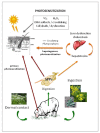Secondary plant products causing photosensitization in grazing herbivores: their structure, activity and regulation
- PMID: 24451131
- PMCID: PMC3907879
- DOI: 10.3390/ijms15011441
Secondary plant products causing photosensitization in grazing herbivores: their structure, activity and regulation
Abstract
Photosensitivity in animals is defined as a severe dermatitis that results from a heightened reactivity of skin cells and associated dermal tissues upon their exposure to sunlight, following ingestion or contact with UV reactive secondary plant products. Photosensitivity occurs in animal cells as a reaction that is mediated by a light absorbing molecule, specifically in this case a plant-produced metabolite that is heterocyclic or polyphenolic. In sensitive animals, this reaction is most severe in non-pigmented skin which has the least protection from UV or visible light exposure. Photosensitization in a biological system such as the epidermis is an oxidative or other chemical change in a molecule in response to light-induced excitation of endogenous or exogenously-delivered molecules within the tissue. Photo-oxidation can also occur in the plant itself, resulting in the generation of reactive oxygen species, free radical damage and eventual DNA degradation. Similar cellular changes occur in affected herbivores and are associated with an accumulation of photodynamic molecules in the affected dermal tissues or circulatory system of the herbivore. Recent advances in our ability to identify and detect secondary products at trace levels in the plant and surrounding environment, or in organisms that ingest plants, have provided additional evidence for the role of secondary metabolites in photosensitization of grazing herbivores. This review outlines the role of unique secondary products produced by higher plants in the animal photosensitization process, describes their chemistry and localization in the plant as well as impacts of the environment upon their production, discusses their direct and indirect effects on associated animal systems and presents several examples of well-characterized plant photosensitization in animal systems.
Figures




Similar articles
-
Mini review on photosensitization by plants in grazing herbivores.Trop Anim Health Prod. 2018 Jun;50(5):925-935. doi: 10.1007/s11250-018-1583-x. Epub 2018 Apr 6. Trop Anim Health Prod. 2018. PMID: 29623517 Review.
-
Wild parsnip (Pastinaca sativa)-induced photosensitization.Toxicon. 2019 Sep;167:60-66. doi: 10.1016/j.toxicon.2019.06.007. Epub 2019 Jun 4. Toxicon. 2019. PMID: 31173794
-
Phototoxicity of herbal plants and herbal products.J Environ Sci Health C Environ Carcinog Ecotoxicol Rev. 2013;31(3):213-55. doi: 10.1080/10590501.2013.824206. J Environ Sci Health C Environ Carcinog Ecotoxicol Rev. 2013. PMID: 24024520 Review.
-
Ketoprofen: experimental overview of dermal toxicity.Arch Toxicol. 2007 Oct;81(10):743-8. doi: 10.1007/s00204-007-0199-0. Epub 2007 Mar 23. Arch Toxicol. 2007. PMID: 17380321
-
Photosensitized growth inhibition of cultured human skin cells: mechanism and suppression of oxidative stress from solar irradiation of glycated proteins.J Invest Dermatol. 2002 Aug;119(2):489-98. doi: 10.1046/j.1523-1747.2002.01788.x. J Invest Dermatol. 2002. PMID: 12190875
Cited by
-
Mini review on photosensitization by plants in grazing herbivores.Trop Anim Health Prod. 2018 Jun;50(5):925-935. doi: 10.1007/s11250-018-1583-x. Epub 2018 Apr 6. Trop Anim Health Prod. 2018. PMID: 29623517 Review.
-
Avoiding toxic levels of essential minerals: a forgotten factor in deer diet preferences.PLoS One. 2015 Jan 23;10(1):e0115814. doi: 10.1371/journal.pone.0115814. eCollection 2015. PLoS One. 2015. PMID: 25615596 Free PMC article.
-
Photodermatitis and ocular changes in nine horses after ingestion of wild parsnip (pastinaca sativa).BMC Vet Res. 2022 Feb 26;18(1):80. doi: 10.1186/s12917-022-03162-2. BMC Vet Res. 2022. PMID: 35219345 Free PMC article.
-
The aetiology, prevalence and morbidity of outbreaks of photosensitisation in livestock: A review.PLoS One. 2019 Feb 27;14(2):e0211625. doi: 10.1371/journal.pone.0211625. eCollection 2019. PLoS One. 2019. PMID: 30811417 Free PMC article.
-
Compounds Involved in the Invasive Characteristics of Lantana camara.Molecules. 2025 Jan 19;30(2):411. doi: 10.3390/molecules30020411. Molecules. 2025. PMID: 39860280 Free PMC article. Review.
References
-
- Croteau R., Kutchman T.M., Lewis N.G. Biochemistry and Molecular Biology of Plants. American Society of Plant Biologists; Rockville, MD, USA: 2000. Natural products (secondary metabolites)
-
- Field B., Jordan F., Osbourn A. First encounters—Deployment of defence-related natural products by plants. N. Phytol. 2006;172:193–207. - PubMed
-
- Weston P.A., Weston L.A., Hildebrand P.A. Metabolic profiling in Echium plantagineum: Presence of bioactive pyrrolizidine alkaloids and naphthoquinones from accenssions across Australia. Phytochem. Rev. 2013;12:831–837.
-
- Wink M. Functions and biotechnology of plant secondary metabolites. Ann. Plant Rev. 1999;39:1–16.
-
- Weston L.A., Mathesius U. Flavonoids: Their structure, biosynthesis and role in the rhizosphere, including allelopathy. J. Chem. Ecol. 2013;39:283–297. - PubMed
Publication types
MeSH terms
Substances
LinkOut - more resources
Full Text Sources
Other Literature Sources

